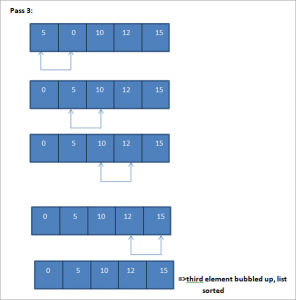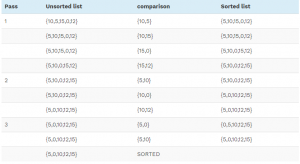Situatie
Bubble Sort is the simplest of the sorting techniques.
In the bubble sort technique, each of the elements in the list is compared to its adjacent element. Thus if there are n elements in list A, then A[0] is compared to A[1], A[1] is compared to A[2] and so on. After comparing if the first element is greater than the second, the two elements are swapped then.
Bubble Sort Technique
Using the bubble sort technique, sorting is done in passes or iteration. Thus at the end of each iteration, the heaviest element is placed at its proper place in the list. In other words, the largest element in the list bubbles up.
Solutie
Pasi de urmat
General Algorithm
Step 1: For i = 0 to N-1 repeat Step 2
Step 2: For J = i + 1 to N – I repeat
Step 3: if A[J] > A[i]
Swap A[J] and A[i]
[End of Inner for loop]
[End if Outer for loop]
Step 4: Exit
Here is a pseudo-code for bubble sort algorithm, where we traverse the list using two iterative loops.
In the first loop, we start from the 0th element and in the next loop, we start from an adjacent element. In the inner loop body, we compare each of the adjacent elements and swap them if they are not in order. At the end of each iteration of the outer loop, the heaviest element bubbles up at the end.
Pseudocode
Procedure bubble_sort (array , N)
array – list of items to be sorted
N – size of array
begin
swapped = false
repeat
for I = 1 to N-1
if array[i-1] > array[i] then
swap array[i-1] and array[i]
swapped = true
end if
end for
until not swapped
end procedure
The above given is the pseudo-code for bubble sort technique. Let us now illustrate this technique by using a detailed illustration.
Illustration
We take an array of size 5 and illustrate the bubble sort algorithm.
As shown in the illustration, with every pass, the largest element bubbles up to the last thereby sorting the list with every pass. As mentioned in the introduction, each element is compared to its adjacent element and swapped with one another if they are not in order.
Thus as shown in the illustration above, at the end of the first pass, if the array is to be sorted in ascending order, the largest element is placed at the end of the list. For the second pass, the second largest element is placed at the second last position in the list and so on.
When we reach N-1 (where N is a total number of elements in the list) passes, we will have the entire list sorted.
C++ Example
Let us see a programming Example to demonstrate the bubble sort.
#include
using namespace std;
int main ()
{
int i, j,temp,pass=0;
int a[10] = {10,2,0,14,43,25,18,1,5,45};
cout <<“Input list …\n”;
for(i = 0; i<10; i++) {
cout <<a[i]<<“\t”;
}
cout<<endl;
for(i = 0; i<10; i++) {
for(j = i+1; j<10; j++)
{
if(a[j] < a[i]) {
temp = a[i];
a[i] = a[j];
a[j] = temp;
}
}
pass++;
}
cout <<“Sorted Element List …\n”;
for(i = 0; i<10; i++) {
cout <<a[i]<<“\t”;
}
cout<<“\nNumber of passes taken to sort the list:”<<pass<<endl;
return 0;
}
Output:
Input list …
10 2 0 14 43 25 18 1 5 45
Sorted Element List …
0 1 2 5 10 14 18 25 43 45
Number of passes taken to sort the list:10





Leave A Comment?